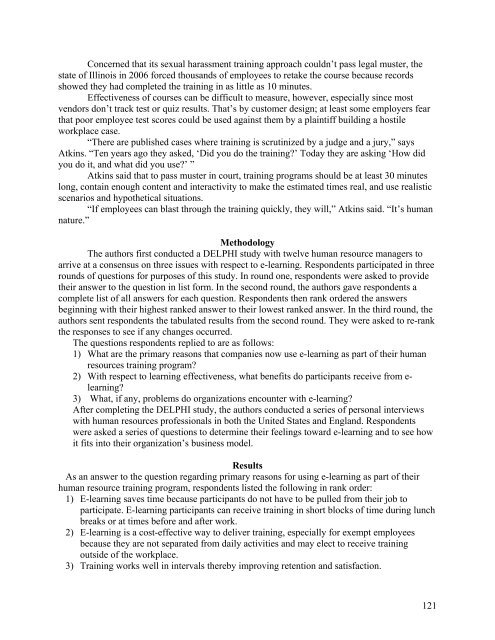2008 PROCEEDINGS - Public Relations Society of America
2008 PROCEEDINGS - Public Relations Society of America
2008 PROCEEDINGS - Public Relations Society of America
Create successful ePaper yourself
Turn your PDF publications into a flip-book with our unique Google optimized e-Paper software.
Concerned that its sexual harassment training approach couldn’t pass legal muster, the<br />
state <strong>of</strong> Illinois in 2006 forced thousands <strong>of</strong> employees to retake the course because records<br />
showed they had completed the training in as little as 10 minutes.<br />
Effectiveness <strong>of</strong> courses can be difficult to measure, however, especially since most<br />
vendors don’t track test or quiz results. That’s by customer design; at least some employers fear<br />
that poor employee test scores could be used against them by a plaintiff building a hostile<br />
workplace case.<br />
“There are published cases where training is scrutinized by a judge and a jury,” says<br />
Atkins. “Ten years ago they asked, ‘Did you do the training?’ Today they are asking ‘How did<br />
you do it, and what did you use?’ ”<br />
Atkins said that to pass muster in court, training programs should be at least 30 minutes<br />
long, contain enough content and interactivity to make the estimated times real, and use realistic<br />
scenarios and hypothetical situations.<br />
“If employees can blast through the training quickly, they will,” Atkins said. “It’s human<br />
nature.”<br />
Methodology<br />
The authors first conducted a DELPHI study with twelve human resource managers to<br />
arrive at a consensus on three issues with respect to e-learning. Respondents participated in three<br />
rounds <strong>of</strong> questions for purposes <strong>of</strong> this study. In round one, respondents were asked to provide<br />
their answer to the question in list form. In the second round, the authors gave respondents a<br />
complete list <strong>of</strong> all answers for each question. Respondents then rank ordered the answers<br />
beginning with their highest ranked answer to their lowest ranked answer. In the third round, the<br />
authors sent respondents the tabulated results from the second round. They were asked to re-rank<br />
the responses to see if any changes occurred.<br />
The questions respondents replied to are as follows:<br />
1) What are the primary reasons that companies now use e-learning as part <strong>of</strong> their human<br />
resources training program?<br />
2) With respect to learning effectiveness, what benefits do participants receive from e-<br />
learning?<br />
3) What, if any, problems do organizations encounter with e-learning?<br />
After completing the DELPHI study, the authors conducted a series <strong>of</strong> personal interviews<br />
with human resources pr<strong>of</strong>essionals in both the United States and England. Respondents<br />
were asked a series <strong>of</strong> questions to determine their feelings toward e-learning and to see how<br />
it fits into their organization’s business model.<br />
Results<br />
As an answer to the question regarding primary reasons for using e-learning as part <strong>of</strong> their<br />
human resource training program, respondents listed the following in rank order:<br />
1) E-learning saves time because participants do not have to be pulled from their job to<br />
participate. E-learning participants can receive training in short blocks <strong>of</strong> time during lunch<br />
breaks or at times before and after work.<br />
2) E-learning is a cost-effective way to deliver training, especially for exempt employees<br />
because they are not separated from daily activities and may elect to receive training<br />
outside <strong>of</strong> the workplace.<br />
3) Training works well in intervals thereby improving retention and satisfaction.<br />
121
















